Recurring billing is a powerful tool for businesses looking to offer subscription-based services or products. With PayPal, setting up this payment model is streamlined, enabling organizations to collect fees automatically at predetermined intervals. But just how do you do that, and is there anything you need to know before going ahead with it? This guide will provide a detailed walkthrough on implementing PayPal recurring billing, ensuring your business can efficiently manage subscriber payments and secure a steady revenue stream.
Table of Contents
ToggleWhat are PayPal Recurring Payments?
PayPal automatic billing is an essential feature for businesses aiming to charge their customers automatically on a cycle for products or services. It eliminates the need for a manual transaction process each time a payment is due, offering a streamlined solution for regular billing. This convenience is increasingly valuable in today’s subscription-heavy economy, where services ranging from streaming platforms and gyms to food delivery and media subscriptions are becoming the norm. Automating this process through PayPal not only enhances operational efficiency for businesses but also ensures a smooth transaction experience for customers.
With the advent of PayPal Checkout, setting up recurring payments has become more accessible to businesses of various sizes and sectors. Companies have the flexibility to configure their billing cycles according to three distinct recurring payment models. These options allow for customization in the amount billed, the frequency of charges — be it weekly, monthly, or annually — and the overall duration of the subscription, which can either be an ongoing service or limited to a set number of payments. This range of choices empowers businesses to tailor their payment solutions to fit their unique service offerings and customer needs.
For businesses, the implementation of PayPal recurring payments translates to a dependable and economically efficient method for managing subscriptions and automating the billing cycle. On the flip side, for consumers, it ensures a seamless payment process for services or products they use regularly. The system is designed to safeguard sensitive financial information, providing a secure transaction environment for both parties. By leveraging recurring billing of PayPal, businesses can not only optimize their revenue streams but also enhance customer satisfaction through hassle-free payment methods.
Advantages and Disadvantages of PayPal Recurring Payments
Exploring the benefits and drawbacks of PayPal’s recurring payment feature is crucial for businesses considering this model. Below, we’ve broken down the primary advantages and disadvantages to give you a clear overview. This analysis aims to assist organizations in making an informed decision about whether this payment system aligns with their operational needs and goals.
Advantages
The integration of PayPal’s recurring payments offers numerous benefits to businesses, streamlining both financial management and customer experience. Here are some key advantages:
- Predictable Revenue: Establishes a reliable cash flow system by collecting payments at regular intervals, assisting in accurate financial forecasting and budget planning for sustainable growth.
- Integrated API: Provides a user-friendly integration platform with existing websites or applications, streamlining transaction processes to enhance customer experience and operational efficiency.
- Reduced Administrative Tasks: Automating the billing process significantly reduces the burden of manual billing tasks, enabling the workforce to allocate time and resources to strategic business initiatives for increased productivity and innovation.
- Customer Retention: Automated payment systems foster customer loyalty by simplifying the payment process encouraging repeat business and long-term relationships through hassle-free transactions and convenience.
- Buffer to Payment Failures: Recurring payment mechanisms act as a safeguard against potential payment failures caused by various factors, such as expired payment methods or insufficient funds, ensuring uninterrupted services and customer satisfaction. PayPal’s feature to pause subscriptions after multiple failed attempts mitigate disruptions while carrying over outstanding dues to the next billing cycle and maintains cash flow stability.
- Reports and Status Updates: Access to comprehensive reports and real-time subscription status updates empowers businesses with valuable insights for informed decision-making, enabling proactive management strategies and performance optimization.
Disadvantages
Despite its benefits, PayPal’s recurring payment system also presents some challenges that businesses need to consider.
- Additional Fees: Using this feature incurs extra charges, potentially impacting overall profitability. For instance, PayPal has no monthly or setup fees, but they do charge an additional 3.49% + $0.49 fee per USD transaction for processing automatic payments (fixed fee varies by currency), which could eat into a business’s profits.
- Lack of Flexibility: Customers might feel trapped in a payment plan without the ability to modify it, which can result in frustration and potential loss of business.
How Does PayPal Recurring Payments Work?
PayPal Recurring Payments operates by allowing customers to provide initial authorization for PayPal to deduct the agreed subscription cost directly from their preferred billing method. This authorization can target various payment methods, including credit cards and bank accounts. Once the authorization is in place, PayPal is empowered to automatically process payments following a predetermined schedule, such as weekly, monthly, or any other frequency agreed upon during the subscription setup.
After a customer subscribes, PayPal handles the payment collection process autonomously at set intervals, ensuring businesses receive their payments without any manual intervention unless the customer decides to cancel their subscription. This automatic system not only provides businesses with a predictable revenue stream but also offers a seamless experience for the customer, removing the need to manually make payments for each billing period.
Businesses have a substantial degree of flexibility and control over their subscription plans. Within their PayPal account, they can easily manage subscriber details, track payment transactions, and amend subscription details as required. This includes the ability to customize pricing models—choosing between fixed pricing or quantity-based pricing—and the option to communicate with subscribers via messages, enhancing customer engagement.
Additionally, PayPal Recurring Billing provides businesses with tools to incentivize new subscribers through promotional offerings. These can include free or discounted trials, allowing businesses to attract new customers by lowering the initial cost barrier. This feature not only benefits businesses by potentially increasing their subscriber base but also offers customers the flexibility to try services at a lower risk.
Setting up Recurring Billing on PayPal
Setting up recurring payments with PayPal is a straightforward process that facilitates a seamless transaction flow for subscription-based businesses. This process not only enhances customer experience by providing a hassle-free way to maintain subscriptions but also ensures a steady revenue stream for businesses. Here’s a step-by-step guide on how to implement this feature.
Before You Start
- Ensure you have a PayPal business account.
- Have your account username and password ready.
- Prepare the HTML code for your site to integrate the subscription button or system.
Logging into Your Account
- Sign in to your PayPal business account.
- Navigate to the Manage Subscriptions page within your account dashboard.
Creating Your Plan
- Click on “Create Plan”.
- Fill out the form with your product or service details, including name, description, and product ID.
- Select your product type (physical goods, digital goods, etc.).
Curating Subscription Plan
- Decide on your pricing model – fixed, quantity, volume-based, or tiered-based pricing.
- Fixed: A set price for a service at a predetermined frequency. Example: $10 per month for a streaming service.
- Quantity: Price based on the quantity of goods or services. Example: $6 for a bag of dog treats. If a subscriber orders 10 bags, they are billed $60 for that period.
- Volume-based: Charges are based on the usage or volume of the service consumed. Example: A cloud storage service charging customers based on the gigabytes of data stored.
Detailing Your Plan
- Set up the customer details section.
- Define pricing, including currency, price, and taxes (if applicable).
Billing Cycle Setup
- Choose the length of time for each billing cycle.
- Decide on the total duration of the subscription.
- Specify the number of times customers can miss payments before cancellation.
Finalizing and Activation
- Review all the details of your plan thoroughly.
- Click “Turn On Plan” to activate your subscription plan.
- Optionally, add a subscription button to your website for easier access.
By following these steps, you’ll be able to leverage PayPal’s robust platform for managing recurring payment, ensuring a smooth and efficient billing process for both your business and your customers.
Frequently Asked Questions (FAQs)
Q1: What are the charges incurred by PayPal for recurring payments?
For Currency transactions, when a business processes recurring payments in the same currency as their PayPal account, PayPal levies the standard transaction fee accompanied by a fixed fee specifically for recurring payments in the same currency. This setup is designed to facilitate ease of transactions for domestic subscriptions, providing a cost-effective solution for businesses maintaining operations within a single currency framework.
In scenarios involving Different Currency, where recurring payments are processed in a currency different from that of the PayPal account, businesses should brace for higher fees. PayPal applies a higher transaction fee to accommodate the currency conversion process in addition to the standard transaction fee. The fee for currency conversion is approximately 3.5% above the base exchange rate, which varies depending on the currency.
There’s also an additional percentage-based fee ranging from 0.8% to 1% for international commercial transactions. This fee structure reflects the complexity and risk associated with managing multiple currencies and international transactions, ensuring businesses can extend their services globally while PayPal manages the intricacies of currency exchange.
Q2: Can customers subscribe to a recurring payment plan without a PayPal account?
Yes, PayPal offers customers the option to subscribe to recurring payments without having a PayPal account. Customers can opt for this method by selecting the “Pay with Debit or Credit Card” option at checkout. However, they still have the option to create a PayPal account after completing the transaction.
Q3: Can businesses upgrade or downgrade their subscription plans?
Yes, businesses can easily upgrade or downgrade their recurring payment plans at any time. This feature provides flexibility for adapting to changes in business operations, market demands, and customer preferences. By accessing the “Plan Details” page on their PayPal account, businesses can make necessary changes, such as adjusting pricing models or increasing/decreasing billing cycles. These changes will be reflected in upcoming billing cycles, providing a smooth transition for both businesses and customers.
Q4: Can customers cancel their subscription plans?
Yes, PayPal allows customers to cancel their recurring billing plans at any time. Customers can do so by logging into their PayPal account and navigating to the “Manage Subscriptions” page. From there, they can select the subscription they wish to cancel and click on “Cancel.” Alternatively, customers can contact the business directly for cancellation requests.
Q5: Can businesses set up trial periods for their subscription plans?
Yes, PayPal offers the option to set up trial periods for recurring payment plans. This feature allows businesses to attract potential customers by offering a free or discounted trial period before the regular billing cycle begins. During this period, customers can test out the product or service and decide whether they want to continue with the subscription.
Q6: How can businesses track their subscription metrics and analytics?
PayPal provides businesses with a comprehensive dashboard to track subscription metrics such as subscriber count, revenue, billing cycles, churn rate, and more. This data can help businesses make informed decisions for their recurring payment plans, ensuring they continue to meet the needs of their customers and drive growth. Additionally, PayPal offers integration with other analytics and reporting tools for a more in-depth analysis of subscription data. So, businesses can monitor and optimize their subscription plans for maximum success.
Take Advantage of Recurring Billing with ReliaBills
Just like PayPal, you can also enable your business to take advantage of recurring billing by using a recurring billing solution like ReliaBills. As a cloud-based recurring billing software, ReliaBills enables businesses to automate their billing process and accept payments through multiple channels.
ReliaBills is a cloud-based invoicing and billing software designed to automate payment processes, reduce administrative overhead, and streamline payment processing duties. ReliaBills’ payment processing features include automated recurring billing, payment tracking, payment reminders, online payment processing, and much more!
It also provides valuable tools that help manage customer information, monitor payment records, and create proper billing and collection reports. As a result, invoice and billing management are simple and convenient. You also get access to active customer support, which is ready to assist you whenever you need help.
Get started with ReliaBills for free today! And if you want more features, you can upgrade your account to ReliaBills PLUS for only $24.95 monthly! Subscribing to ReliaBills PLUS will give you access to advanced features such as automatic payment recovery, SMS notifications, custom invoice creation, advanced reporting, and more!
With ReliaBills, you have an all-in-one solution to your invoicing and payment processing needs. Our convenient solutions will enable you to focus more on running and growing your business. Get started today!
How to Create a New Recurring Invoice Using ReliaBills
Creating a New Recurring Invoice using ReliaBills involves the following steps:
Step 1: Login to ReliaBills
- Access your ReliaBills Account using your login credentials. If you don’t have an account, sign up here.
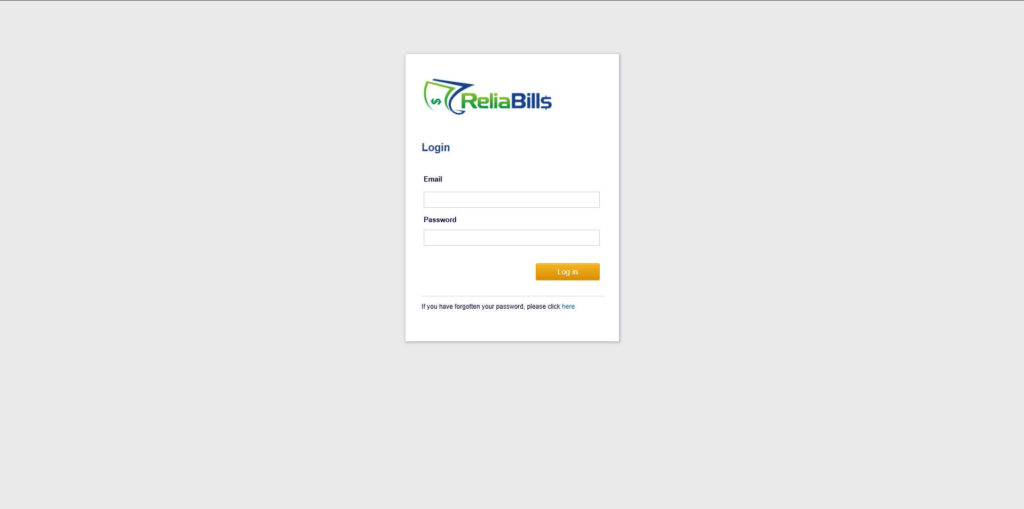
Step 2: Click on Recurring Invoices
- Navigate to the Invoices Dropdown and click on Recurring Invoices for an overview of the list of your existing customers.
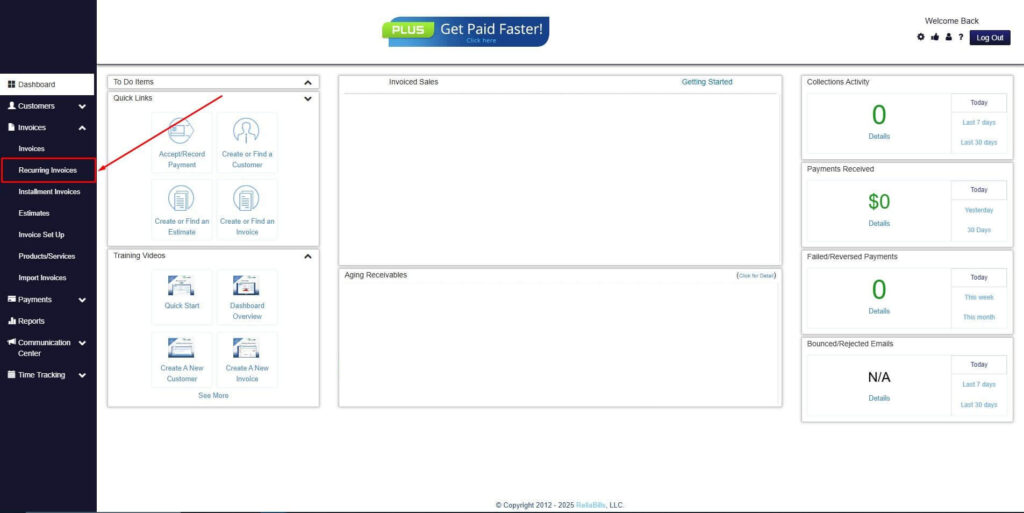
Step 3: Go to the Customers tab
- If you have already created a customer, search for them in the Customers tab and make sure their status is “Active”.
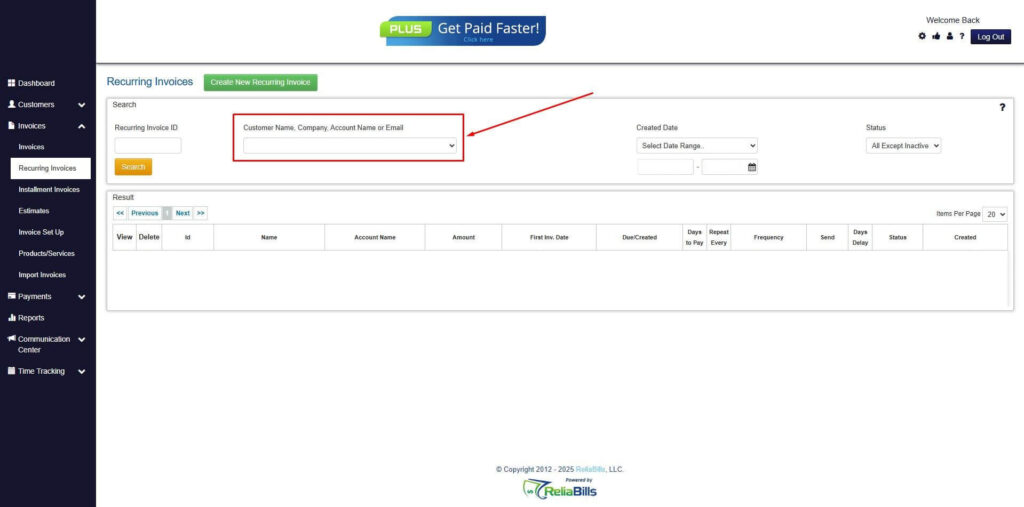
Step 4: Click the Create New Recurring Invoice
- If you haven’t created any customers yet, click the Create New Recurring Invoice to create a new customer.
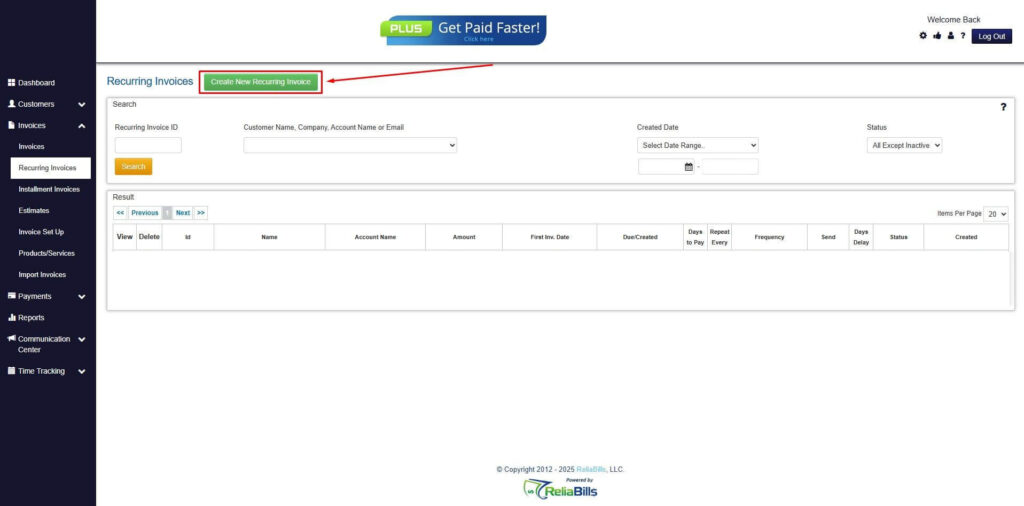
Step 5: Click on the “Click here” button
- Click on the “Click here” button to proceed with the recurring invoice creation.
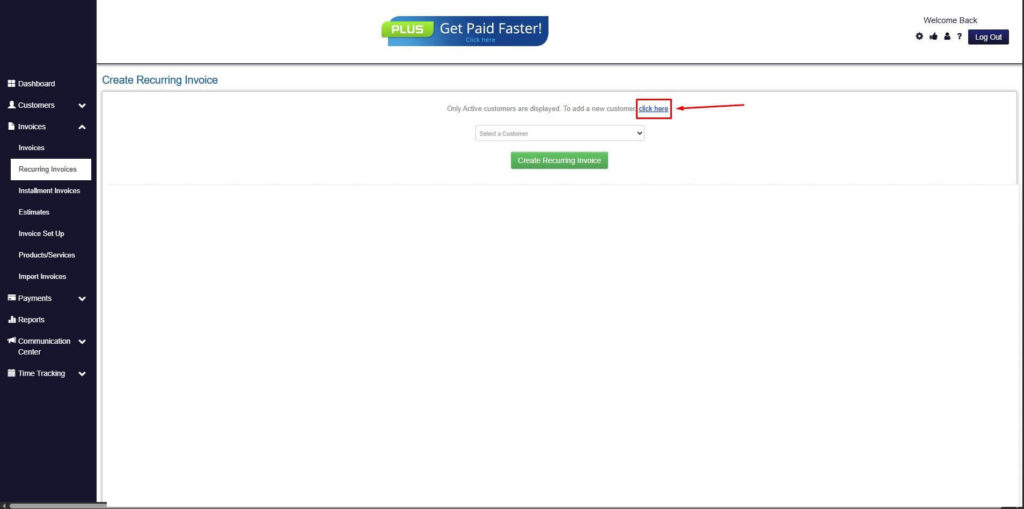
Step 6: Create Customer
- Provide your First Name, Last Name, and Email to proceed.
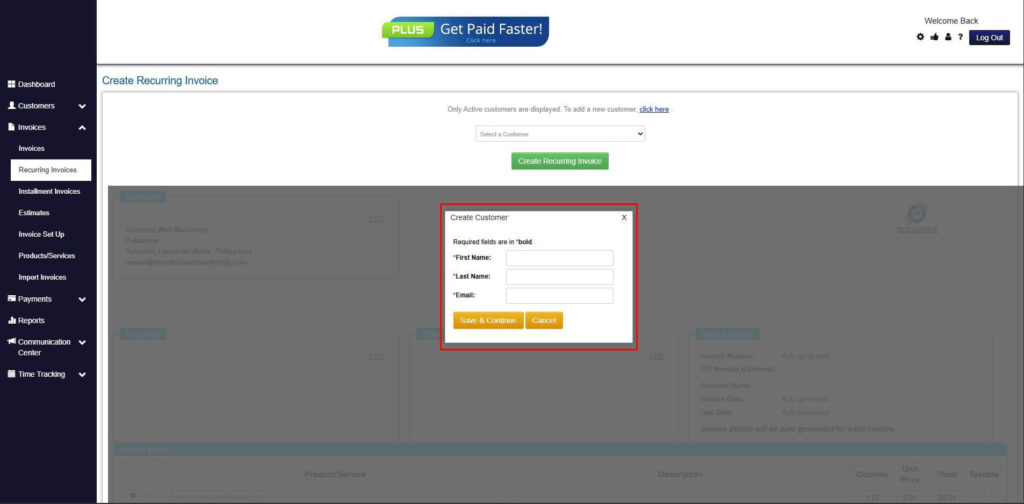
Step 7: Fill in the Create Recurring Invoice Form
- Fill in all the necessary fields.
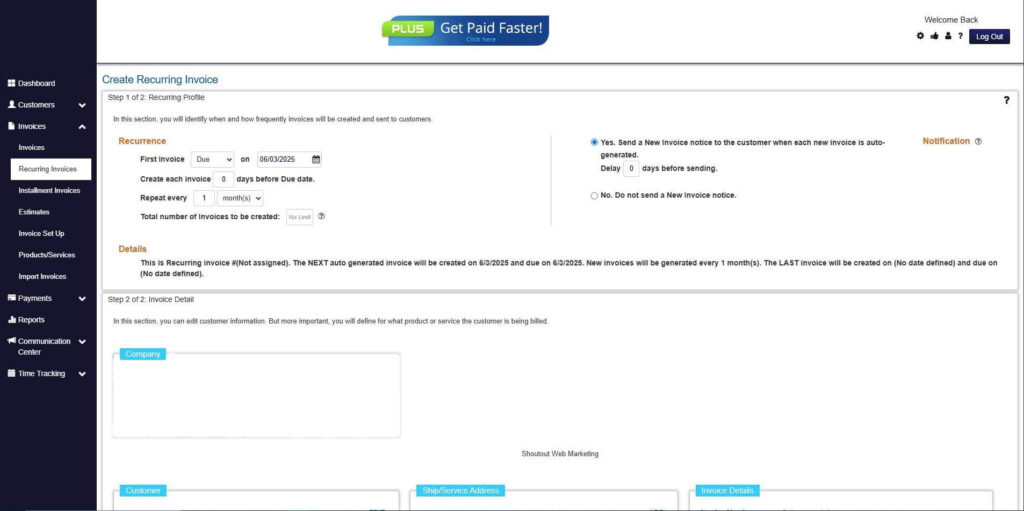
Step 8: Save Recurring Invoice
- After filling up the form, click “Save Recurring Invoice” to continue.
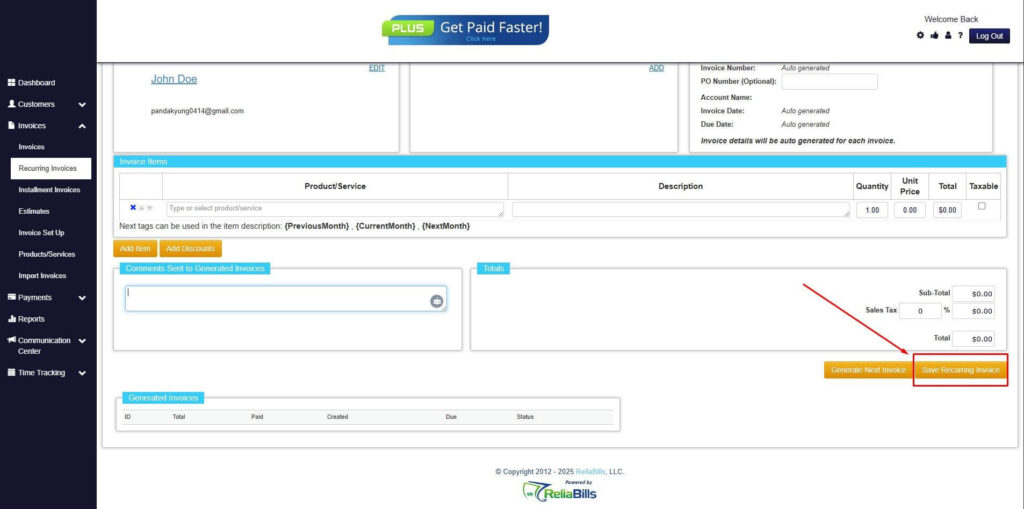
Step 9: Recurring Invoice Created
- Your Recurring Invoice has been created.
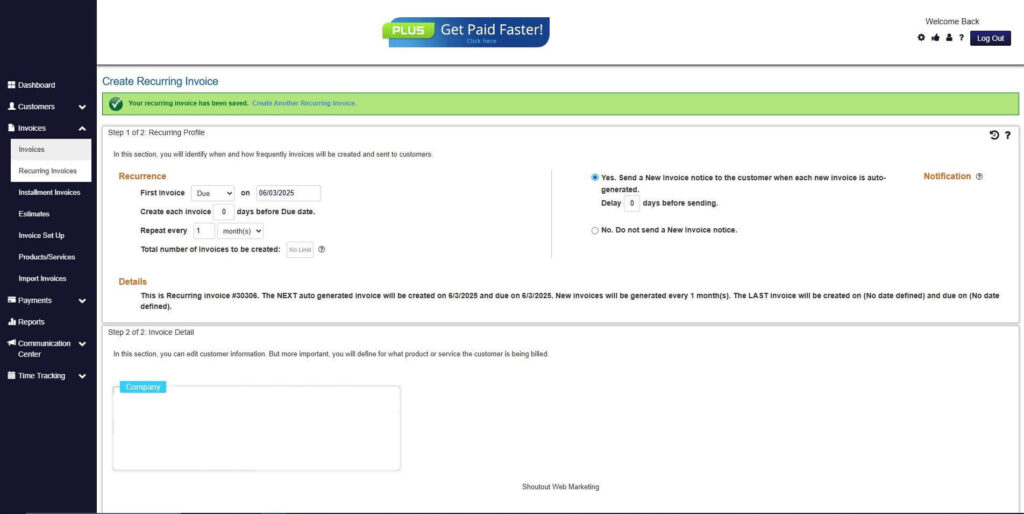
Conclusion
If you want to maximize your PayPal transactions, familiarize yourself with the platform’s features that support recurring payments. Understanding the nuances of setting up subscription plans, managing currency conversions, and utilizing tools for tracking subscription metrics can significantly enhance your business operations.
With PayPal, creating flexible and customer-friendly payment options becomes more practical. This enables businesses to adapt dynamically to market changes and consumer demands. Leveraging the full spectrum of PayPal’s recurring payment features ensures that your business can offer seamless transaction experiences, fostering customer loyalty and driving growth.


